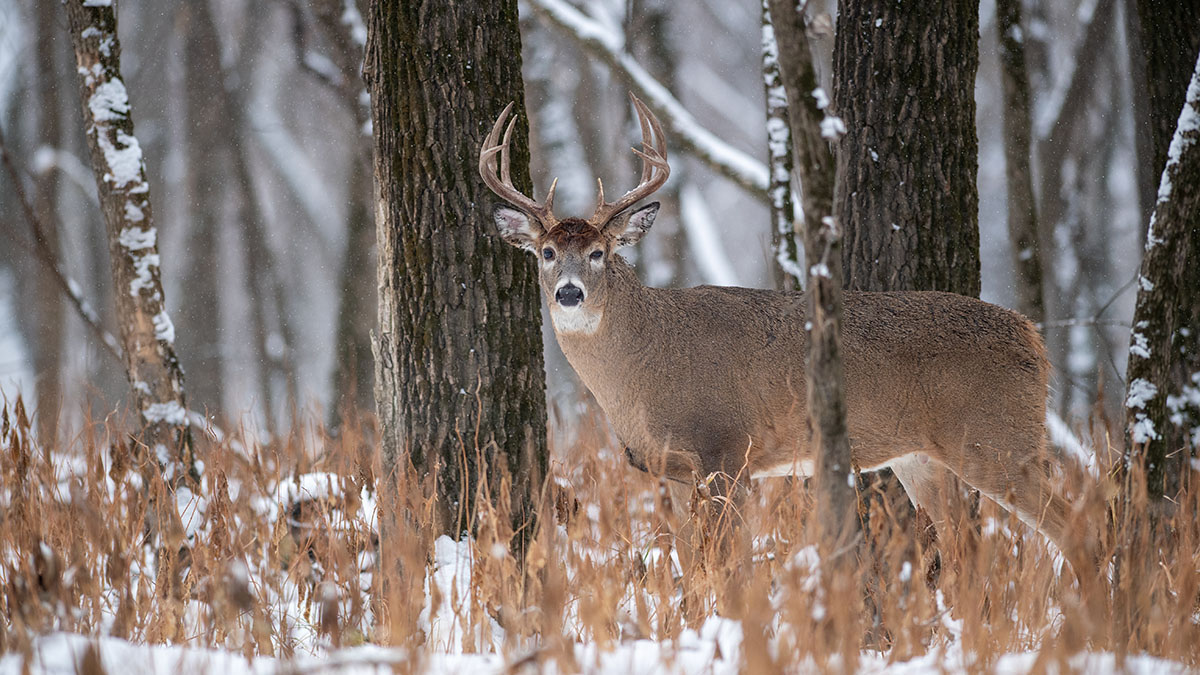
Hunting whitetails in the big woods is complex. With very few designated food sources, thick cover seemingly everywhere for deer to bed, and low deer densities, the rut is the one time of year when you can increase your odds of success.
It’s easy to get caught up in trying to figure out all the details and having paralysis by analysis. Doe bedding, buck bedding, food sources, and everything in between can be tough to identify when hunting the big woods unless you have years of experience in the area. However, you can still find success by identifying rut funnels without having all the details nailed down.
Saddles
A saddle is a low point between two higher points on a ridge. Animals use saddles for travel from the bottom to the top of the ridge or over into the next valley. They can be a great place to set up during the rut since it acts like a funnel for deer travel.
I like to set up on the leeward side of the saddle, meaning the side of the hill where the prevailing wind is blowing. With that being said, saddles are the most talked about rut hunting location in areas with hills or mountains and can create added pressure.
Last year in New York, the saddles were covered with tree stands and hunter sign—not an ideal location to hunt. In areas with high pressure, consider working your way off one side of the saddle or the other, depending on the cover and wind. Instead, check out the next micro terrain feature, such as a small bench that leads to and from the saddle. Otherwise, you might still see immature bucks in those saddles, but a mature buck would have to be zombie-walking to make that mistake in daylight.
Topo Hubs
Topo hubs are areas where three or more ridges converge at a common point. These are easy to identify on a map if you think about it like spokes on a wheel. These places will put you in the center of several travel routes, making them focal points during the rut.
I look for vegetation edges within these topo hubs to find the exact location to set up. It’s important to identify the macro area on a map, but even more important to find that micro-location or exact spot where you can get a buck within bow range. The name of the game during the rut is to increase your odds of a buck cruising by, and with multiple ridges and draws converging in one area, it’s tough to beat hunting a topo hub.
Draws
A draw is a depression that slopes downward, usually with a small stream running through the middle of it. The upper end of a draw tends to be less steep, creating a travel corridor for the deer to move. Right where the steep ravine meets a more gradual terrain can be the perfect place to set up with a stand or off the ground above the trail to catch deer moving.
I like to set up above the trail during the rut, because I find more midday movement in these locations, and want to take advantage of the uphill thermals. When hunting draws, I will enter from the bottom in the morning using the downward thermals after daylight with a plan to be set up in time for the thermals to switch. When hunting the big woods in hill country, thermals can be your friend or enemy. Setting up above the trail will get you winded while the thermals are falling. Get a little extra sleep and sit the rest of the day.
Edges of Logging Cuts
Timber cuts provide great browse food sources and bedding cover for deer. Does like to bed in timber cuts, which creates the perfect scenario for bucks to cruise the downwind side of the cut, checking doe paths and hoping to catch a whiff of a hot doe bedded down for the day.
Ensure you can shoot into the thick cover on the edge and combine it with a feature such as a draw or an inside corner of the cut to increase the odds of bucks moving through that particular spot. The old bucks don’t like to travel in the open and use the edge just inside the cover. Does like to use the areas cut 3 to 8 years ago that have enough cover and plenty of browse food sources.
Beaver Ponds
Beaver ponds create natural funnels. Ponds at the bottom of a hub with multiple ridges running into the bottom will create a natural cruising pathway, while the beaver pond itself makes the choke point to help you fine-tune your setup.
Consider setting up on the top or bottom of the pond where you can funnel the most deer movement from the sides and at the crossing itself. These areas provide more midday travel than first thing in the morning or evenings, so you might have to pack a lunch and stay put for a few days.
Rut funnels might look a little different in the big woods, but keeping in mind the simple facts that deer like edges, bucks are looking for does, and they’ll use terrain to their advantage will help you find the rut funnel that could lead to you filling your next tag on a chocolate-antlered big woods buck.






Conversation